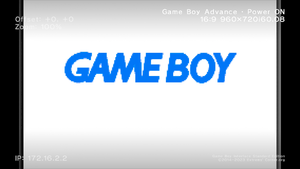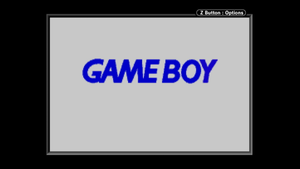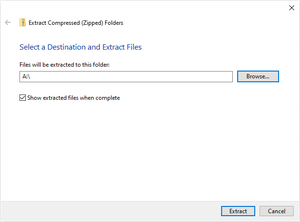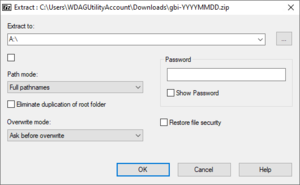Game Boy Interface
| Information | |
|---|---|
| Author(s) | Extrems |
| Type | Utility |
| Version | Rolling release |
| Licence | All rights reserved |
| Links | |
|
Download main package Download extra package | |
| Website | |
| Discussion | |
| Source | |
| This software must not be sold, neither alone nor as part of a bundle. If you paid for this software or received it as part of a bundle following payment, you have been scammed and should demand your money back immediately. |
| Firmware update notice for GCVideo products. It is strongly recommended to update to GCVideo-DVI v3.0 or later before using this software. GCVideo Lite products are not recommended under any circumstances. |


Game Boy Interface is a free alternative to the Game Boy Player Start-up Disc software. It still requires the Game Boy Player hardware.
Game Boy Interface is currently available in three different editions: Standard, Speedrunning and High-Fidelity.
Overview
The standard edition is ideal for sample-and-hold displays (LCD, OLED). By default, it emulates some aspects of the color and sound reproduction of the original handheld. With a Broadband Adapter and USB Gecko in hand, it can be used as a small Game Boy Advance development kit.
The speedrunning edition is ideal for impulse displays (CRT, 1ms MPRT LCD, Plasma) or use with the RetroTINK-2X. It attempts to be a non-controversial improvement for speedrunners. To ease transition, it can be configured to closely mimic the Game Boy Player Start-up Disc.
The high-fidelity edition is ideal for use with the Open Source Scan Converter, RetroTINK-4K, RetroTINK-5X Pro, XRGB-mini Framemeister, or using solely a video capture device and software processing. Given the right setup, it can offer audiovisual quality comparable to emulation on newer platforms. It is less than suitable for direct display connection, with some exceptions. Any non-mentioned use is unintended.
All editions can emulate the color and sound reproduction of the original handheld if desired.
Its original mission was to solve the temporal judder present with the Game Boy Player Start-up Disc through temporal interpolation. This feature remains exclusive to the standard edition.
TL;DR
- Datapath VisionAV or VisionRGB? →
gbihf-vision.dol+cliorgbisr-vision.dol+cli - RetroTINK-4K? →
gbihf-rt4k-hdmi.dol+cliorgbisr-vision.dol+cli - PixelFX Morph4K or Open Source Scan Converter (Pro)? →
gbihf-ossc.dol+cliorgbihf-ossc+carby.dol+cli - PixelFX RetroGEM GC? →
gbihf-gem-sdr.dol+cliorgbihf-gem-hdr.dol+cli - RetroTINK-5X Pro? →
gbihf-ossc.dol+cliorgbi-rt5x+carby.dol+cli - XRGB-mini Framemeister? →
gbihf-xrgb.dol+cli - Cathode-ray tube computer monitor? →
gbihf-direct-vga.dol+cliorgbisr.dolwith default settings - Nintendo GameCube Component Video Cable? →
gbihf-direct-ypbpr.dol+cliorgbihf.dolwith default settings - GCVideo-DVI v3.0 and later? →
gbihf-direct-hdmi.dol+cliorgbi.dolwith default settings - GCVideo-DVI v2.4d and earlier? →
gbisr-direct-hdmi.dol+cliorgbi.dolwith default settings - RetroTINK-2X? →
gbisr.dolwith default settings - Anything* else →
gbisr.dolorgbi.dolwith default settings
If you have something truly exotic, hopefully you don't need a tl;dr.
GBA-as-controller
Turn your Game Boy Advance into a Nintendo 64 or Nintendo GameCube Controller using the Game Boy Advance Cable, compatible with any hardware supporting such controllers.
Rumble is supported using the following Game or Option Paks:
e-Reader dot codes and multi-bootable ROMs are provided in the extra package for untethered use from Game Boy Interface.
It also prolongs battery life over the Game Boy Player Start-up Disc with power saving trickery, while maximizing performance.
GBA dumper
Holding Start + Select in the Game Boy Player while the Game Boy logo is visible will grant you access to a dumping utility. From there, you can dump your GBA BIOS, ROM, or save data.
An SD Card and SD Card Adapter is required. In the speedrunning edition, this is substituted by a built-in GBA ROM checksumming utility.
TAS playback
Game Boy Interface has a built-in movie playback feature, allowing for the console verification of GBC-on-GBA and GBA tool-assisted speedruns, all without hardware modification.
A few console-verified movies are included in the extra package (*.txt.gz), and more can be found at Runs.TAS.Bot. An SD Card and SD Card Adapter is required.
Installation


SD Media Launcher
- Obtain the SD Media Launcher and an SDSC Card (≤2 GB).
- Format the SDSC Card as FAT(16).
- Extract the main package to the root directory of the SDSC Card. Do not extract to
gbi-YYYYMMDD. - (Optional) Merge
GBI/from the extra package withGBI/on the SDSC Card. - (Optional) Rename the desired
.dolor.dol+clifile on the SDSC Card toAUTOEXEC.DOL.
Important: GBI/, MCBACKUP/ and AUTOEXEC.DOL must reside in the root directory. Extracting files selectively may result in loss of functionality.
SD Media Launcher with Swiss
- Obtain the SD Media Launcher and an SDSC Card (≤2 GB).
- Format the SDSC Card as FAT(16).
- Extract the main package to the root directory of the SDSC Card. Do not extract to
gbi-YYYYMMDD. - (Optional) Merge
GBI/from the extra package withGBI/on the SDSC Card. - Copy
ActionReplay/AUTOEXEC.DOLfrom the Swiss release to the root directory of the SDSC Card. - (Optional) Set the hidden file attribute on
AUTOEXEC.DOL.
Important: GBI/, MCBACKUP/ and AUTOEXEC.DOL must reside in the root directory. Extracting files selectively may result in loss of functionality. .cli files are required for Swiss.
SD Media Launcher + SD2SP2 with Swiss
- Obtain the SD Media Launcher, an SDSC Card (≤2 GB), an SD2SP2 and a microSD Card.
- Format the microSD Card for the SD2SP2 as FAT(16), FAT32 or exFAT.
- Extract the main package to the root directory of the microSD Card for the SD2SP2. Do not extract to
gbi-YYYYMMDD. - (Optional) Merge
GBI/from the extra package withGBI/on the microSD Card for the SD2SP2. - Format the SDSC Card for the SD Media Launcher as FAT(16).
- Copy
ActionReplay/AUTOEXEC.DOLfrom the Swiss release to the root directory of the SDSC Card for the SD Media Launcher. - (Optional) Set the hidden file attribute on
AUTOEXEC.DOL.
Important: GBI/, MCBACKUP/ and AUTOEXEC.DOL must reside in the root directory. Extracting files selectively may result in loss of functionality. .cli files are required for Swiss.
Memory Card + SD Card Adapter
- Obtain a Super Smash Bros. Melee Game Disc, a Memory Card, an SD Card Adapter and an SD Card.
- Format the SD Card as FAT(16) or FAT32.
- Extract the main package to the root directory of the SD Card. Do not extract to
gbi-YYYYMMDD. - (Optional) Merge
GBI/from the extra package withGBI/on the SD Card. - Rename the desired
.dolor.dol+clifile on the SD Card toboot.dol. - (Optional) Backup the Memory Card.
- Format the Memory Card on a system of the same region.
- Restore Home Bros. to the Memory Card.
Important: GBI/, MCBACKUP/ and boot.dol must reside in the root directory. Extracting files selectively may result in loss of functionality.
Memory Card + SD Card Adapter with Swiss
- Obtain a vulnerable Game Disc, a Memory Card (≥251 blocks), an SD Card Adapter or SD2SP2 and an SD Card.
- Format the SD Card as FAT(16), FAT32 or exFAT.
- Extract the main package to the root directory of the SD Card. Do not extract to
gbi-YYYYMMDD. - (Optional) Merge
GBI/from the extra package withGBI/on the SD Card. - (Optional) Backup the Memory Card.
- Format the Memory Card on a system of the same region.
- Restore a usable game save exploit to the Memory Card.
- Restore
GCI/boot.gcifrom the Swiss release to the Memory Card.
Important: GBI/ and MCBACKUP/ must reside in the root directory. Extracting files selectively may result in loss of functionality. .cli files are required for Swiss.
Memory Card
- Obtain a vulnerable Game Disc and a Memory Card.
- (Optional) Backup the Memory Card.
- Format the Memory Card on a system of the same region.
- Restore a usable game save exploit to the Memory Card.
- Restore the desired
.gcifile from the main package to the Memory Card.
Note: An SD Card Adapter is required for reading/writing data. Certain functionality will be lost.
GC Loader + SD Card Adapter
- Install the GC Loader.
- Obtain an SD Card Adapter or SD2SP2 and two SD Cards.
- Format the SD Card for the SD Card Adapter as FAT(16), FAT32 or exFAT.
- Extract the main package to the root directory of the SD Card for the SD Card Adapter. Do not extract to
gbi-YYYYMMDD. - (Optional) Merge
GBI/from the extra package withGBI/on the SD Card for the SD Card Adapter. - Rename the desired
.dolor.dol+clifile on the SD Card for the SD Card Adapter toboot.dol. - Format the SDHC/SDXC Card for the GC Loader as FAT32 or exFAT.
- Copy
boot.isofrom the extra package to the root directory of the SDHC/SDXC Card for the GC Loader.
Important: GBI/, MCBACKUP/, boot.dol and boot.iso must reside in the root directory. Extracting files selectively may result in loss of functionality.
GC Loader + SD Card Adapter with Swiss
- Install the GC Loader.
- Obtain an SD Card Adapter or SD2SP2 and two SD Cards.
- Format the SD Card for the SD Card Adapter as FAT(16), FAT32 or exFAT.
- Extract the main package to the root directory of the SD Card for the SD Card Adapter. Do not extract to
gbi-YYYYMMDD. - (Optional) Merge
GBI/from the extra package withGBI/on the SD Card for the SD Card Adapter. - Format the SDHC/SDXC Card for the GC Loader as FAT32 or exFAT.
- Copy
GCLoader/boot.isofrom the Swiss release to the root directory of the SDHC/SDXC Card for the GC Loader. - (Optional) Set the hidden file attribute on
boot.iso.
Important: GBI/, MCBACKUP/ and boot.iso must reside in the root directory. Extracting files selectively may result in loss of functionality. .cli files are required for Swiss.
GC Loader with Swiss
- Install the GC Loader.
- Obtain an SDHC/SDXC Card (≥4 GB).
- Format the SDHC/SDXC Card as FAT32 or exFAT.
- Extract the main package to the root directory of the SDHC/SDXC Card. Do not extract to
gbi-YYYYMMDD. - (Optional) Merge
GBI/from the extra package withGBI/on the SDHC/SDXC Card. - Copy
GCLoader/boot.isofrom the Swiss release to the root directory of the SDHC/SDXC Card. - (Optional) Set the hidden file attribute on
boot.iso. - Upgrade the GC Loader firmware to 2.0.0.BETA or later.
Important: GBI/, MCBACKUP/ and boot.iso must reside in the root directory. Extracting files selectively may result in loss of functionality. .cli files are required for Swiss.
IPL (PicoBoot) + SD Card Adapter
- Install gekkoboot to a supported IPL replacement.
- Obtain an SD Card Adapter and an SD Card.
- Format the SD Card as FAT(16), FAT32 or exFAT.
- Extract the main package to the root directory of the SD Card. Do not extract to
gbi-YYYYMMDD. - (Optional) Merge
GBI/from the extra package withGBI/on the SD Card. - Rename the desired
.dolor.dol+clifile on the SD Card toipl.dol.
Important: GBI/, MCBACKUP/ and ipl.dol must reside in the root directory. Extracting files selectively may result in loss of functionality.
IPL (PicoBoot) + SD Card Adapter with Swiss
- Install gekkoboot to a supported IPL replacement.
- Obtain an SD Card Adapter and an SD Card.
- Format the SD Card as FAT(16), FAT32 or exFAT.
- Extract the main package to the root directory of the SD Card. Do not extract to
gbi-YYYYMMDD. - (Optional) Merge
GBI/from the extra package withGBI/on the SD Card. - Copy
DOL/swiss_rXXXX.dolfrom the Swiss release to the root directory of the SD Card. - Rename
swiss_rXXXX.dolon the SD Card toipl.dol. - (Optional) Set the hidden file attribute on
ipl.dol.
Important: GBI/, MCBACKUP/ and ipl.dol must reside in the root directory. Extracting files selectively may result in loss of functionality. .cli files are required for Swiss.
FlippyDrive + SD Card Adapter with Swiss
- Install the FlippyDrive.
- Obtain an SD Card Adapter or SD2SP2 and two SD Cards.
- Format the SD Card for the SD Card Adapter as FAT(16), FAT32 or exFAT.
- Extract the main package to the root directory of the SD Card for the SD Card Adapter. Do not extract to
gbi-YYYYMMDD. - (Optional) Merge
GBI/from the extra package withGBI/on the SD Card for the SD Card Adapter. - Format the microSD Card for the FlippyDrive as FAT(16), FAT32 or exFAT.
- Copy
FlippyDrive/boot.dolfrom the Swiss release to the root directory of the microSD Card for the FlippyDrive. - (Optional) Set the hidden file attribute on
boot.dol.
Important: GBI/, MCBACKUP/ and boot.dol must reside in the root directory. Extracting files selectively may result in loss of functionality. .cli files are required for Swiss.
FlippyDrive
- Install the FlippyDrive.
- Obtain a microSD Card.
- Format the microSD Card as FAT(16), FAT32 or exFAT.
- Copy the desired
.dolor.dol+clifile from the main package to the root directory of the microSD Card.
Note: An SD Card Adapter is required for reading/writing data. Certain functionality will be lost.
DVD (XenoGC) + SD Card Adapter
- Install an available drive chip.
- Obtain a blank DVD±R, an SD Card Adapter or SD2SP2 and an SD Card.
- Format the SD Card as FAT(16) or FAT32.
- Extract the main package to the root directory of the SD Card. Do not extract to
gbi-YYYYMMDD. - (Optional) Merge
GBI/from the extra package withGBI/on the SD Card. - Rename the desired
.dolor.dol+clifile on the SD Card toboot.dol. - Burn
boot.gcmfrom the extra package to the blank DVD±R.
Important: GBI/, MCBACKUP/ and boot.dol must reside in the root directory. Extracting files selectively may result in loss of functionality.
DVD (XenoGC) + SD Card Adapter with Swiss
- Install an available drive chip.
- Obtain a blank DVD±R, an SD Card Adapter or SD2SP2 and an SD Card.
- Format the SD Card as FAT(16) or FAT32.
- Extract the main package to the root directory of the SD Card. Do not extract to
gbi-YYYYMMDD. - (Optional) Merge
GBI/from the extra package withGBI/on the SD Card. - Copy
DOL/swiss_rXXXX.dolfrom the Swiss release to the root directory of the SD Card. - Rename
swiss_rXXXX.dolon the SD Card toboot.dol. - (Optional) Set the hidden file attribute on
boot.dol. - Burn
boot.gcmfrom the extra package to the blank DVD±R.
Important: GBI/, MCBACKUP/ and boot.dol must reside in the root directory. Extracting files selectively may result in loss of functionality. .cli files are required for Swiss.
DVD (XenoGC) + Memory Card
- Install an available drive chip.
- Obtain a blank DVD±R and a Memory Card.
- Restore the desired
.gcifile from the main package to the Memory Card. - Burn
boot.gcmfrom the extra package to the blank DVD±R.
Note: An SD Card Adapter is required for reading/writing data. Certain functionality will be lost.
DVD (XenoGC)
This method is unsupported at this time.
Configuration
As Game Boy Interface still lack configuration files or a full user interface, this is done through command-line arguments.
Using Swiss
When loading a .dol file, Swiss first look for a .dcp file. This file contain a limited set of options that can be interactively changed before starting Game Boy Interface. This set of options can be expanded upon, but prior to Swiss v0.6r1424, is limited to 16 options with 8 choices of 31 characters. Note that the default shown positions don't represent the default settings.
For a more permanent or advanced configuration, a .cli file can be used. This file contain command-line arguments on separate lines.
A list of options and example configurations can be found in the subpage for each edition.
Using wiiload
Game Boy Interface can be reloaded using its built-in wiiload server with command-line arguments passed on to the wiiload client.
New overlays can also be uploaded in this fashion.
Other
The contents of a .cli file can be appended to a .dol file to form a .dol+cli file. The file must end with a blank line due to the hacky nature of this method.
When using a game save exploit, the resulting .dol+cli file can be converted to a .gci file using dol2gci.exe from the extra package.
Support
Licence
Copyright (c) 2014-2025, Extrems' Corner.org All rights reserved. You may not sell or redistribute this software. All trademarks used are properties of their respective owners.